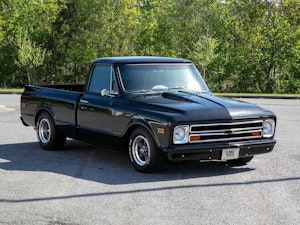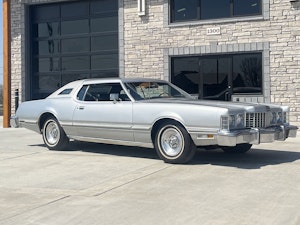Media | Articles
One man’s quest to save the endangered Capri
Just as sales of the Mustang and its competitors began to sputter in the early 1970s, a new breed of smaller sporty coupe emerged, led, coincidentally, by the Mustang’s svelte European Ford cousin, the Capri. British and German Ford factories built nearly two million Capris from 1969 until 1986. In America, Ford offered the German-built model through its Lincoln-Mercury dealers, selling nearly a half-million from 1971–1977.
As the first-generation Mustang did in America, the Capri became a collectible in Europe, as well as in Australia and New Zealand. Here, however, the Capri performed a disappearing act, spurred by depreciation, rust, and—to some extent—expensive and difficult-to-get parts. As a result, most of the Capris sold in America have vanished.
“They got used up, like Bic lighters, and thrown away,” says Norm Murdock, whose purchase of a used Capri while in college in 1978 drove his passion for racing and restoring these compact coupes. “They were not thought of as collector cars here and were scrapped. It didn’t make sense to keep putting money into them unless you just loved the car.”
Murdock started Team Blitz in 1979 to sell performance parts for the Capri and to manage his racing efforts. He later founded the Capri Club of North America (now run by a son, Paul) and still races a Capri in SCCA F-Stock. Today, Team Blitz is the key supplier of Capri parts in America and also serves international customers. Murdock estimates there may be a “couple thousand” Capris on the road in the U.S., and that interest in the car is on the rise.
Marketplace
Buy and sell classics with confidence
20180116152430)
“We’re attracting new owners,” he says. “Baby boomers are interested in the Capri, and more cars are popping up.”
Murdock says his business stocks some three million parts for the Capri, from light bulbs to body parts and racing components. That availability, he explains, makes it feasible to resurrect a worn-out model.
“It’s easier to restore a Capri today than it’s ever been,” Murdock says, describing a major reversal from the situation in the years following the car’s departure from this market. “Ford had a poor track record with maintaining parts for its orphaned European models, including the Cortina, Capri, and Merkur. Parts started becoming hard to get pretty quickly after Ford stopped importing the Capri.”
Thrown away, but now restorable
The parts supply problem accelerated the Capri’s “throw-away” nature. In the late 1970s, the strength of the dollar against the Deutschmark made the German-made Capri’s replacement parts expensive, especially for something not usually kept in stock. As an example, Murdock cites the driveshaft, which was an odd two-piece affair with non-replaceable u-joints.
“If you had a u-joint go out, you’d have to order a new driveshaft from a dealer, and it cost $400 in the 1970s,” Murdock says. “Today, we sell a brand new driveshaft for less than $400, and it has replaceable u-joints. Adjusted for inflation, it’s much cheaper now.”
The 2.3-liter four-cylinder and 2.8-liter V-6 engines used in the 1974–77 Capri continued beyond that in several American Ford car and truck models, and mechanical and service parts remained widely available. Murdock says, however, that there was a 10–15-year gap between the end of Capri imports and when the aftermarket began to furnish restoration parts.
“My plan was to acquire as much inventory from Ford as possible and then develop my own parts, including weather-stripping, body panels, interior parts—the kind of things a dealership would quickly discontinue,” he says.
20180116152553)
20180116152327)
Murdock touts having two-dozen NOS rear quarter panels available, and newly commissioned parts include wheel arch panels and rocker panels. Many Capri owners modify their cars for better performance, and Murdock offers intakes, headers, big brake packages, limited-slip differentials, wide wheels, and more.
The company also builds complete engines and transmissions. For those who want even more power, an available conversion kit makes it easy to install a Ford small-block V-8 in a Capri. Murdock owns four rare Euro-market Capris RS 2600 race homologation specials, including an original factory race car. He acquired the molds used by Ford to make fiberglass fenders, hoods, and trunk lids for the racers and offers those parts, as well.
Rotting metal, cracking plastic, and expat Capris
Murdock acknowledges that finding a good restoration candidate remains a challenge.
“You’re not going to find a rust-free Capri, even in California, after 40–45 years,” he says. “It’s going to have rust somewhere, unless you luck into a mint car. They exist, but they’re rare.” (Such a car, a 1976 model, sold at the Bonhams Greenwich auction in June 2017 for nearly $16,000.)
The Capri’s A-pillars and rear frame rails are particularly prone to rust, and Murdock cautions against buying a car showing major damage in those structural areas.
“If there’s rust in the frame rail where it goes over the rear axle, or where the leaf springs attach, it’s probably financially unsound to restore that car,” he says. “We have the parts to fix those areas, but unless you have the skills, you’ll pay a shop a small fortune to do the work.”
20180116152359)
Rust was not the Capri’s only weakness. Early models used some cheap interior parts, including a kind of pressed cardboard with an “elephant skin” pattern for the rear package shelf and a small storage shelf under the dashboard. Those areas were easily broken with normal usage. In addition, the Capris’ interior plastics cracked easily in hot, dry climates, something Murdock says was common for European cars from the era.
Capris that survived into the 1990s and beyond became attractive to overseas collectors, and so some cars made the trip back across the Atlantic.
“When the dollar was weak, Europeans were buying Capris on eBay and shipping them to Germany and England,” Murdock says. “I know guys who were buying Capris for under $1,000 and selling them for $3,000 just by advertising in Europe.”
That trend has subsided as values have risen here, but Murdock says restoring a Capri is more out of love for the car than as an investment.
“Restoration labor costs would be about the same as for a typical Mustang, but the Mustang is likely to hold at least twice the Capri’s value,” he says.
20180116152947)










i like the capri alot it my faveriat car i preaseve sales broshers and advertiments do you have enyting that i can buy from you
It’s not unique that the *later * and the earlier Capris have faded from memory as MOST cars do here in the US! The MG was the first sports car for perhaps the majority of enthusiasts in the forties’ and fifties and only older enthusiast’s recall them despite their LONG SUCCESSFULL SPORTING HISTORY! EVEN the exotics become obscure and cheap in 10 or 20 years after they come out, I’ve bought many!! I bought an Aston Martin for $1300, a 120 Jag for about the same , passed up a nice 65 GT350 for $2500 paid 1600 for my Lotus Cortina and about the same for the last Lotus 51 formula car etc!
BTW!! The first Capri neglecting the earlier Lincoln Capri was the 61-64 –Not counsel any more than the Cortina being called the Counsel Cortina despite the earlier ones having a name sign on its bonnet that said counsel Cortina! Ford has NEVER known anything about sports cars, they have always been in the EVERYMAN’S CAR MANUFACTURING BUSINESS, THE EARLY CAPRI CAME OUT WITH THEIR PRIDE: A VERY ADVANCED ENGINE FOR A FAMILY USER CAR BUT TOTALLY WRONG FOR MOTORSPORTS! BY THE TIME THEY REALISED THAT AND CONTRACTED COSWORTH WHICH DEVELOPED and PRODUCED their FIRST street engine! They realised that the Capri would compete with the much less expensive to produce–and therefore more profitable Mustang so STOPPED PROMOTING IT IN THE STATES COMPLETLY! IF YOU GO OVER THE CAR MAGS OF THAT PERIOD YOU’LL FIND ALMOST NOTHING MENTIONED ABOUT THE CAPRI GT, EVEN NOW HAGERTY HAS NOTHING ABOUT IT OR ANY CAPRI!!!! The Ford Escort ZX2 like it’s predecessors has the right bones to be a significant motorsports car but never found a savior like SHELBY or Lotus’s Chapman!
My first car was a ’74 (or ’75–same both years) Capri, V-6 in blue. My Dad already had a ’74 in blue also, but with the 4 cylinder engine. Boy, mine would fly. I loved that car. I’d be interested in getting another.